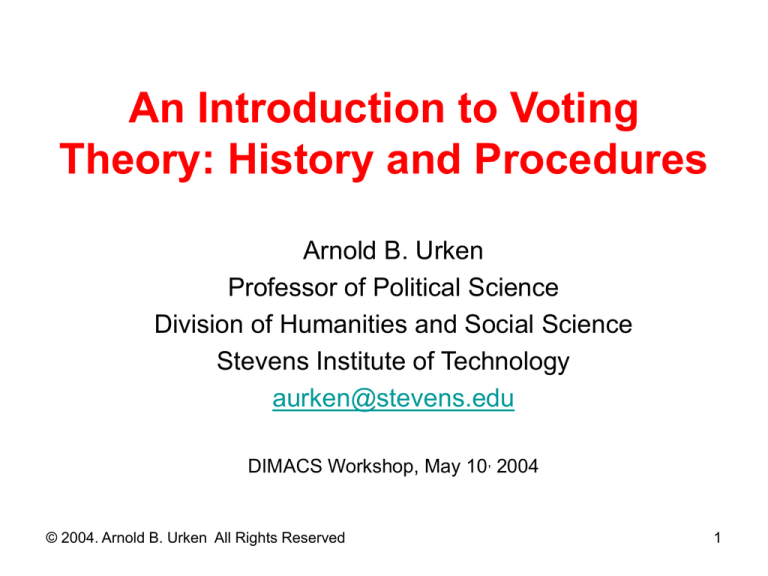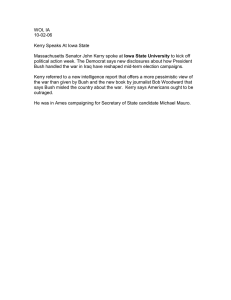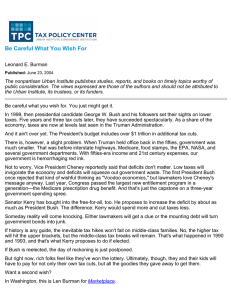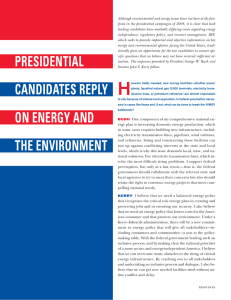
An Introduction to Voting
Theory: History and Procedures
Arnold B. Urken
Professor of Political Science
Division of Humanities and Social Science
Stevens Institute of Technology
aurken@stevens.edu
DIMACS Workshop, May 10, 2004
© 2004. Arnold B. Urken All Rights Reserved
1
Outline
Top Six Voting Systems
Pre-18th Century Voting Theory
18th Century France: The Golden Age?
The Rediscovery of Voting Theory
Preference Aggregation Issues
Competence in Voting Theory
© 2004. Arnold B. Urken All Rights Reserved
2
Top Six Voting Systems
Plurality voting
Borda voting
Condorcet scoring
Copeland scoring
Approval voting
STV (IRV)
© 2004. Arnold B. Urken All Rights Reserved
3
Top Six Voting Systems
[continued]
Voting systems include rules for
Vote Endowment: number of votes used to
express preferences
Vote Allocation: Saving or trading?
Vote Aggregation: Standard for producing a
collective outcome.
Allocation => “fungible voting,” which
allows votes to be saved and traded
© 2004. Arnold B. Urken All Rights Reserved
4
Hypothetical Data Set
Ranks
1st
2nd
3rd
John
Bush
Kerry
Nader
Mary
Kerry
Nader
Bush
Joe
Nader
Kerry
Bush
Tom Ruth
Kerry Nader
Nader Bush
Bush Kerry
Steve
Bush
Nader
Kerry
Debby
Bush
Kerry
Nader
Ed
Bush
Nader
Kerry
Jack
Kerry
Nader
Bush
Nine voters rank
1. Bush
2. Kerry
3. Nader
© 2004. Arnold B. Urken All Rights Reserved
5
Top Six Voting Procedures
[continued]
Plurality Voting
Endowment: One vote for the most preferred choice
Allocation: Trading/saving not explicitly allowed
Aggregation: Choice with the most votes wins (plurality)
© 2004. Arnold B. Urken All Rights Reserved
6
Plurality Voting Results
Ranks
1st
2nd
3rd
John
Bush
Kerry
Nader
Mary
Kerry
Nader
Bush
Joe
Nader
Kerry
Bush
Tom Ruth
Kerry Nader
Nader Bush
Bush Kerry
Bush
4 votes
Kerry
3 votes
Nader
2 votes
© 2004. Arnold B. Urken All Rights Reserved
Steve
Bush
Nader
Kerry
Debby
Bush
Kerry
Nader
Ed
Bush
Nader
Kerry
Jack
Kerry
Nader
Bush
7
Plurality vs. Majority
What’s the Difference?
Absolute vs. relative majority
Historically
Sanior et major pars
Right/healthy and greater part
Used to overturn outcomes
Sanior difficult to measure, so major used
© 2004. Arnold B. Urken All Rights Reserved
8
Top Six Voting Procedures
[continued]
Borda Voting
Endowment: Assign ranks to choices
Allocation: Trading/saving not explicitly allowed
Aggregation: Choice with the most votes wins
(plurality)
© 2004. Arnold B. Urken All Rights Reserved
9
Borda Voting Results
Ranks
1st
2nd
3rd
John
Bush
Kerry
Nader
Mary
Kerry
Nader
Bush
Bush
Nader
Kerry
Joe
Nader
Kerry
Bush
Tom Ruth
Kerry Nader
Nader Bush
Bush Kerry
Steve
Bush
Nader
Kerry
Debby
Bush
Kerry
Nader
Ed
Bush
Nader
Kerry
Jack
Kerry
Nader
Bush
18 points
18 points
18 points
Plurality aggregation not satisfied.
© 2004. Arnold B. Urken All Rights Reserved
10
Borda and Rankings
First Place
Bush
Kerry
Nader
Second Place Third Place
x
x
Illegal in some elections
© 2004. Arnold B. Urken All Rights Reserved
11
Borda and Rankings
[continued]
First Place
Bush
Kerry
Nader
x
Second Place Third Place
x
x
Not used this way
© 2004. Arnold B. Urken All Rights Reserved
12
Top Six Voting Procedures
[continued]
Condorcet Scoring
Endowment: Ordinal rankings assigned to choices
Allocation: Trading/saving not explicitly allowed
Aggregation: Winner is the choice with the most
victories in binary comparisons
© 2004. Arnold B. Urken All Rights Reserved
13
Condorcet Scoring Results
Ranks
1st
2nd
3rd
John
Bush
Kerry
Nader
Mary
Kerry
Nader
Bush
Joe
Nader
Kerry
Bush
Bush
Kerry
Nader
Tom Ruth
Kerry Nader
Nader Bush
Bush Kerry
Steve
Bush
Nader
Kerry
Debby
Bush
Kerry
Nader
Ed
Bush
Nader
Kerry
Jack
Kerry
Nader
Bush
9 points
9 points
9 points
Plurality aggregation not satisfied.
© 2004. Arnold B. Urken All Rights Reserved
14
Top Seven Voting Procedures
[continued]
Copeland Scoring
Endowment: Ordinal rankings assigned to choices
Allocation: Trading/saving not explicitly allowed
Aggregation: Winner is the choice with greatest net
score in binary comparisons
© 2004. Arnold B. Urken All Rights Reserved
15
Copeland Scoring Results
Ranks
1st
2nd
3rd
John
Bush
Kerry
Nader
Mary
Kerry
Nader
Bush
Bush
Nader
Kerry
Joe
Nader
Kerry
Bush
Tom Ruth
Kerry Nader
Nader Bush
Bush Kerry
Steve
Bush
Nader
Kerry
Debby
Bush
Kerry
Nader
Ed
Bush
Nader
Kerry
Jack
Kerry
Nader
Bush
0 points
0 points
0 points
Plurality aggregation not satisfied.
© 2004. Arnold B. Urken All Rights Reserved
16
Top Seven Voting Procedures
[continued]
Approval Voting
Endowment: N votes where N = number of choices
Allocation: One vote cast for each approved
choice; no trading/saving
Aggregation: Plurality, majority, or unanimity
© 2004. Arnold B. Urken All Rights Reserved
17
Approval Voting Results
Assuming one approval vote is cast for 1st and 2nd place choices
Ranks
1st
2nd
3rd
John
Bush
Kerry
Nader
Mary
Kerry
Nader
Bush
Bush
Nader
Kerry
Joe
Nader
Kerry
Bush
Tom Ruth
Kerry Nader
Nader Bush
Bush Kerry
Steve
Bush
Nader
Kerry
Debby
Bush
Kerry
Nader
Ed
Bush
Nader
Kerry
Jack
Kerry
Nader
Bush
5 points
6 points
5 points
Nader is the plurality winner!
Based on the number of voters who approve him
© 2004. Arnold B. Urken All Rights Reserved
18
Top Seven Voting Procedures
[continued]
Observations about Approval Voting
Empirical observation: Voters cast an approval
vote for each choice ≥ average utility
Ties possible under plurality, majority, and
unanimous aggregation rules
Definitions of base for aggregation
All allocated votes
The number of voters casting votes
© 2004. Arnold B. Urken All Rights Reserved
19
Top Seven Voting Procedures
[continued]
STV (IRV--Proportional Representation)
Endowment: Assign ranks to choices
Allocation: One choice for each rank, trading/saving: not explicitly
allowed
Aggregation: Majority of first place votes, but if no choice wins, eliminate
the most choice most frequently ranked last and count first
place preferences again until a majority winner is produced
© 2004. Arnold B. Urken All Rights Reserved
20
STV (IRV—Proportional) Scoring Results
Ranks
1st
2nd
3rd
John
Bush
Kerry
Nader
Mary
Kerry
Nader
Bush
Joe
Nader
Kerry
Bush
Tom Ruth
Kerry Nader
Nader Bush
Bush Kerry
Bush
Kerry
Nader
Steve
Bush
Nader
Kerry
Debby
Bush
Kerry
Nader
Ed
Bush
Nader
Kerry
Jack
Kerry
Nader
Bush
4 points
3 points
2 points
Majority aggregation not satisfied.
© 2004. Arnold B. Urken All Rights Reserved
21
STV (IRV—Proportional) Scoring Results
One Round of Elimination
Ranks John Mary Joe
1st
Kerry Kerry Nader
2nd
Nader Nader Kerry
3rd
Bush
Kerry
Nader
Tom Ruth Steve Debby Ed
Jack
Kerry Nader Nader Kerry
Nader Kerry
Nader Kerry Kerry Nader Kerry Nader
Deleted Information
Eliminated
5 votes
4 votes
Kerry is the majority winner!
© 2004. Arnold B. Urken All Rights Reserved
22
PR with Strategic Voting
Ranks
1st
2nd
3rd
John
Bush
Kerry
Nader
Mary
Kerry
Nader
Bush
Joe
Nader
Kerry
Bush
Tom Ruth
Kerry Nader
Nader Bush
Bush Kerry
Steve
Bush
Nader
Kerry
Debby
Bush
Kerry
Nader
Ed
Bush
Nader
Kerry
Jack
Kerry
Nader
Bush
Strategic Voting
Rank John Mary Joe Tom Ruth Steve Debby Ed
Jack
1st
Bush Kerry Nader Kerry Nader Bush Bush
Bush Kerry
2nd
Nader Kerry Nader Kerry
Nader
3rd
First Round Elimination
Rank John Mary Joe Tom Ruth Steve Debby Ed
Jack
1st
Bush Kerry Kerry Kerry Kerry Bush Bush
Bush Kerry
2nd
3rd
© 2004. Arnold B. Urken All Rights Reserved
23
Summary of Results
Method
Plurality
Majority
Borda
Condorcet
Copeland
Approval (Plurality)
Approval (Majority)
PR (IRV) Sincere
PR (IRV) Strategic
© 2004. Arnold B. Urken All Rights Reserved
Winner
Bush
None
Tie
Tie
Tie
Nader
None
Kerry
Kerry
24
Pre-18th Century Voting Theory
General Observations
Theoretical insights were derived from
practical problem solving
Knowledge was not cumulative
The communication of votes was an
issue “Science” was
• “pre-normal” Kuhnian framework
• early stage Popperian “metaphysical”
research program
© 2004. Arnold B. Urken All Rights Reserved
25
Pre-18th Century Voting Theory
[continued]
Pliny the Younger
Ramon Lull
Nicolaus Cusanus
The Venetian Mehod
© 2004. Arnold B. Urken All Rights Reserved
26
Pre-18th Century Voting Theory
[continued]
Pliny the Younger
Letter to Titius Aristo, A.D. 105
Agenda manipulation in the trial of Afranius Dexter’s
slaves
Slaves accused of murdering his master
Options
Acquittal
Banishment
Death
© 2004. Arnold B. Urken All Rights Reserved
27
Pre-18th Century Voting Theory
[continued]
Execution faction leader leads switch from death to
banishment
Banishment is the majority choice
Pliny’s faction favored leniency, but included less than
one-half of all votes
© 2004. Arnold B. Urken All Rights Reserved
28
Pre-18th Century Voting Theory
[continued]
Pliny calls for ternary vote (with division of the whole)
Pliny knew that the opposition had the following
preference orders:
Death > Banishment > Acquittal
Banishment > Acquittal > Death
© 2004. Arnold B. Urken All Rights Reserved
29
Pre-18th Century Voting Theory
[continued]
Why?
Neither Acquittal nor Death would get a majority in the
first round of voting—in binary comparisons
In the second round of voting, the winner of the first
round of voting (Acquittal or Death) would lose to
Banishment
Sincere and manipulated voting produce the same
outcome!
Pliny uncomfortable: inconsistent with Senate customs?
© 2004. Arnold B. Urken All Rights Reserved
30
Pre-18th Century Voting Theory
[continued]
Issues Raised
Sincere voting: honest communication of
preferences
Strategic voting: changing “sincere” votes to
manipulate the collective outcome
Pliny anticipates Robin Farquharson,
Theory of Voting. Yale, 1969
© 2004. Arnold B. Urken All Rights Reserved
31
Pre-18th Century Voting Theory
[continued]
Ramon Lull A.D. 1232-1316
Explored methods for honest church elections
Two methods based on selections of pairs of
choices from a larger set of ranked choices
Blanquera (1285)
De Arte Eleccionis (1299)
© 2004. Arnold B. Urken All Rights Reserved
32
Pre-18th Century Voting Theory
[continued]
Blanquerna (1285)
Mixed method (“art”) Borda and Condorcet
Electors choose Blanquerna as bishop without
following the “art” they generate an indecisive outcome
and the decision must be appealed to the Pope to
produce a winner
Work reflects ambivalence about preference
aggregation and making the right choice.
© 2004. Arnold B. Urken All Rights Reserved
33
Pre-18th Century Voting Theory
[continued]
De Arte Eleccionis (1299)
Condorcet scoring
Uses matrix notation (next used by Dodgson in the 19th
century)
Method does not address collective intransitivity (later
discovered by Condorcet and Arrow)
© 2004. Arnold B. Urken All Rights Reserved
34
Pre-18th Century Voting Theory
[continued]
Nicolaus Cusanus (1430)
Goal: design an “honest” voting procedure to elect a Holy
Roman Emperor to end a long schism in the papacy
Proposes a Borda system
Applies it to propositions with more than two choices
Criticizes manipulation of electorsand criticizes attempts to
control the collective outcome by manipulating electors.
Implicitly suggests that voting by ballot is new
© 2004. Arnold B. Urken All Rights Reserved
35
Pre-18th Century Voting Theory
[continued]
The Venetian Method (13th Century)
Similar to approval voting
Simplified the process of selecting 41
electors from an initial assembly of 1500
members.
© 2004. Arnold B. Urken All Rights Reserved
36
18th Century France: The Golden Age?
Voting in the French Academy of
Sciences
Borda, Condorcet, and others
Condorcet and the French Revolution
Daunou and after
Proportional voting
© 2004. Arnold B. Urken All Rights Reserved
37
18th Century France: The Golden Age?
[continued]
Voting in the French Academy of Sciences
Scientists recommend top three candidates
to the King of France
Plurality voting used since 1699, ties rare.
1770 Borda talk about plurality voting
Borda paper not published until 1784
© 2004. Arnold B. Urken All Rights Reserved
38
18th Century France: The Golden Age?
[continued]
Voting in the French Academy of Sciences
Borda and Condorcet were political
enemies
Borda fought in the American Revolution
Condorcet, a modernist, won a
manipulated election as Secretary
© 2004. Arnold B. Urken All Rights Reserved
39
18th Century France: The Golden Age?
[continued]
Voting in the French Academy of Sciences
No evidence of actual voting debate
Condorcet regards Borda’s work as physicaille
(petty experiments)
Condorcet’s 1785 Essai
Essai sur l’application d’analyse à probabilité des
décisions rendues à la pluralité des voix
© 2004. Arnold B. Urken All Rights Reserved
40
18th Century France: The Golden Age?
[continued]
Voting in the French Academy of Sciences
The 1785 Essai
Goal: analyze the probability of making a
correct collective choice
Introduction: identifies collective
intransitivity
Body: 13 hypothetical situations
© 2004. Arnold B. Urken All Rights Reserved
41
Condorcet “Jury Theorem”
Question: How does majority
rule affect the group probability
of making a correct choice?
Assumptions
• 50 or more
voters
1.0
• Binary choice
0.5
• One Person,
One Vote
• Preferences a
random variable
0
0
0.5
1.0
Individual Voter Competence
© 2004. Arnold B. Urken All Rights Reserved
• Individual
competence
statistically
independent
42
18th Century France: The Golden Age?
[continued]
Condorcet and the French Revolution
Creates practical voting plan for the
Republican Constitution with binary agendas
Recommends jury design for the trial of the
King of France
Robespierre’s hit list drives him underground
Dies in prison?
© 2004. Arnold B. Urken All Rights Reserved
43
18th Century France: The Golden Age?
[continued]
Daunou and after
FAS becomes the Institute of France
New election method needed
Napoléon interested
Borda and Daunou on commission
Daunou writes critique of Borda voting
© 2004. Arnold B. Urken All Rights Reserved
44
18th Century France: The Golden Age?
[continued]
Daunou and after (continued)
Voting theory is lost in French probability
theory (Cf. Daston)
Ideas rediscovered by Dodgson (Lewis
Carroll)
Nanson (Australia) refers to Condorcet’s
ideas in designing elections for scientists
© 2004. Arnold B. Urken All Rights Reserved
45
18th Century France: The Golden Age?
[continued]
Daunou and after (continued)
Proportional voting developed for
allocating seats in legislatures
Ideas are not integrated with voting
theorists
© 2004. Arnold B. Urken All Rights Reserved
46
The Rediscovery of Voting Theory
Black
Does archival research on Condorcet
Coins “jury theorem” to explain
Condorcet’s interest in competence
Develops “single-peakedness” concept
to explain collective intransitivity
© 2004. Arnold B. Urken All Rights Reserved
47
The Rediscovery of Voting Theory
[continued]
Arrow
Relies on Black to understand Condorcet
Invents the term “social choice”
Axiomatizes collective intransitivity
problem in impossibility theorem
© 2004. Arnold B. Urken All Rights Reserved
48
The Rediscovery of Voting Theory
[continued]
Arrow
Unrestricted domain or universality
Non-imposition or citizen sovereignty
Non-dictatorship
Monotonicity
Independence of irrelevant
alternatives
Impossible to satisfy all conditions simultaneously
© 2004. Arnold B. Urken All Rights Reserved
49
The Rediscovery of Voting Theory
[continued]
Brams and Fishburn
Develop formal proposal for approval
voting
Scientific societies adopt approval voting
Articulate theoretical and empirical
arguments
© 2004. Arnold B. Urken All Rights Reserved
50
The Rediscovery of Voting Theory
[continued]
Saari
Develops a geometric framework for
comparing voting methods for three
choices
Does not address
Ties
Truncated preferences
Competence
© 2004. Arnold B. Urken All Rights Reserved
51
The Rediscovery of Voting Theory
[continued]
Preference Aggregation Issues
Vote trading and fungible voting
Manipulation: potential vs. actual
Voter use of voting methods
Ranking choices (STV)
Identifying approved set of choices
© 2004. Arnold B. Urken All Rights Reserved
52
The Rediscovery of Voting Theory
[continued]
Competence in Social Choice
Young: Maximum likelihood
interpretation of Condorcet’s rule
Grofman (Owen, Feld)
Explore models of competence
Show that Condorcet solved Rousseau’s
problem of reconciling “general will” and
the “will of all”
© 2004. Arnold B. Urken All Rights Reserved
53
The Rediscovery of Voting Theory
[continued]
Grofman-Shapley Theorem
How to weight votes in interdependent collective decisions
Don’t weight votes by using the ratio of
p/1-p (ratio of competence to incompetence)
Instead use
ln p/1-p
Experimental Confirmation
© 2004. Arnold B. Urken All Rights Reserved
54
Average individual
competence equals
group competence.
Average
individual does
better than the
group.
1.0
Group does
better than the
average
individual
0.5
00
0.5
1.0
Individual Voter Competence
Non-monotonic pattern in approval voting
© 2004. Arnold B. Urken All Rights Reserved
55
Reconciling Competence and Preferences
1.0
Minimum group
competence
Optimal
group
competence
0.5
Better than
minimum
performance
0
Suboptimal
performance
0.5
1.0
Average Voter Competence
Low
© 2004. Arnold B. Urken All Rights Reserved
High
56
Perspective
History not of purely antiquarian interest
Draws our attention to models and
problems of integrating ideas
Unresolved dualism
Preference aggregation
Competence
© 2004. Arnold B. Urken All Rights Reserved
57






